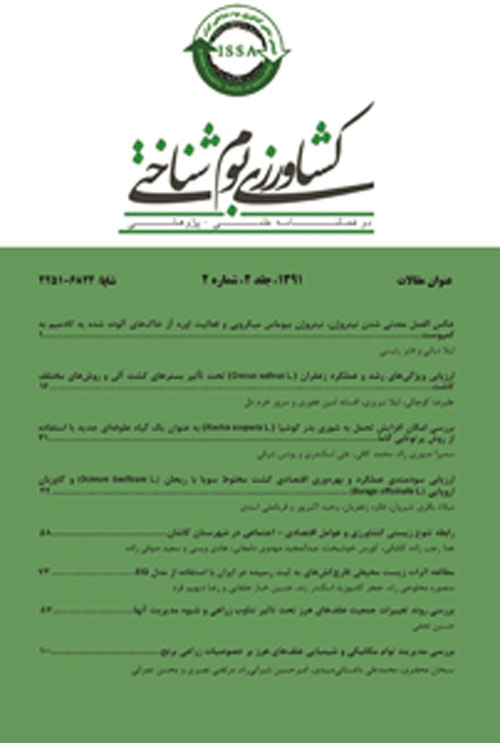Investigation of weed species diversity under the influence of different weed management methods in potato (Solanum tuberosum L.)
Author(s):
Abstract:
Introduction
Most farmers use various management strategies to minimize weed damage, and such management practices can have direct or indirect impacts on biodiversity in agricultural ecosystems (Koocheki et al, 2006). Use of various mulch and tillage methods with the application of herbicides causes greater confidence in effective weed control and can be used as one of the major methods of weed control in potato crop (Bellinder et al, 2000). The aim of this study was the evaluation of weed composition under the influence different kinds of weed management methods in potato crop.Materials And Methods
The experiment was performed in 2015 on two locations at the agricultural research stations of Alarogh and Samian in Ardebil Province in a randomized complete block design with three replications. The treatments included 1) spraying Trifluralin between potato rows, 2) spraying Metribuzin between potato rows, 3) cultivator practice between planting lines, 4) usage of plants containing wheat stubble, 5) usage of plants containing Canola stubble, 6) usage of black polyethylene mulch, 7) usage of transparent polyethylene mulch and 8) control (no weed control in all growth duration) treatment.Results And Discussion
From 12 weed species observed in this study, Common Amaranth (Amaranthus retroflexus), Common lambsquarters (Chenopodium album), Bindweed (Convolvulus arvensis), Green foxtail (Setaria viridis), Prickly lettuce (Lactuca seriola), Russian knapweed (Acroptilon repens) and Milk thistle (Sonchus arvensis), were dominant with the highest rate of weed prevalence. The averages of any ShannonWiener and Simpson indices were changed in both locations so that only the diversity of the Shannon-Weaver index showed a statistically significant difference with change in the kind of weed management. The greatest diversity of both indices was observed in weed infested treatment. Based on the results of Baskin et al (2004) and Milberg (1997), lack of weed control in farmland or fallow land increased weed density and caused an increase in weed density and can also have an effect on species diversity. Based on the Shannon-Wiener index the treatments comprising the use of Trifluralin, cultivators and transparent plastic with values of 1.11, 1.04 and 0.99, respectively, after the weed infested treatment had the highest species diversity. The lowest number of weed species based on the Shannon-Wiener and Simpson indices, similarly, was related to the treatments of canola stubble mulch, Metribuzin herbicide and black plastic mulch, respectively. Hence, with potato weed density at both stations being significantly under the influence of experimental treatments, the mulch, herbicide and cultivator treatments had a significant effect on potato weed density in both locations so that the lowest density of weeds was obtained in wheat stubble mulch and canola stubble mulch. The density of Common Amaranth, Common lambsquarters and Bindweed species, all important weeds, decreased in all mulch, cultivation and herbicide treatments as compared to the weed infested treatment. The highest Common Amaranth density was observed in the treatments of black plastic mulch, Trifluralin and transparent plastic mulch, respectively. Common lambsquarters had the highest density under Metribuzin herbicide treatments.Conclusion
In this study, density of annual weeds was higher than that of perennial weeds; in other words, the highest density of weeds was related to annual weeds. But canola stubble reduced weed density and biomass more compared with the control to the amount of 83 and 81 percent, respectively, and the wheat stubble application reduced weed density and weed biomass to the amount of 79 and 84 percent, respectively. This shows that the use of herbicides, plastic and plant mulch and cultivator can significantly reduce weed density and biomass. Keywords:
Language:
Persian
Published:
Journal of Agroecology, Volume:6 Issue: 2, 2017
Page:
294
magiran.com/p1680993
دانلود و مطالعه متن این مقاله با یکی از روشهای زیر امکان پذیر است:
اشتراک شخصی
با عضویت و پرداخت آنلاین حق اشتراک یکساله به مبلغ 1,390,000ريال میتوانید 70 عنوان مطلب دانلود کنید!
اشتراک سازمانی
به کتابخانه دانشگاه یا محل کار خود پیشنهاد کنید تا اشتراک سازمانی این پایگاه را برای دسترسی نامحدود همه کاربران به متن مطالب تهیه نمایند!
توجه!
- حق عضویت دریافتی صرف حمایت از نشریات عضو و نگهداری، تکمیل و توسعه مگیران میشود.
- پرداخت حق اشتراک و دانلود مقالات اجازه بازنشر آن در سایر رسانههای چاپی و دیجیتال را به کاربر نمیدهد.
دسترسی سراسری کاربران دانشگاه پیام نور!
اعضای هیئت علمی و دانشجویان دانشگاه پیام نور در سراسر کشور، در صورت ثبت نام با ایمیل دانشگاهی، تا پایان فروردین ماه 1403 به مقالات سایت دسترسی خواهند داشت!
In order to view content subscription is required
Personal subscription
Subscribe magiran.com for 70 € euros via PayPal and download 70 articles during a year.
Organization subscription
Please contact us to subscribe your university or library for unlimited access!



